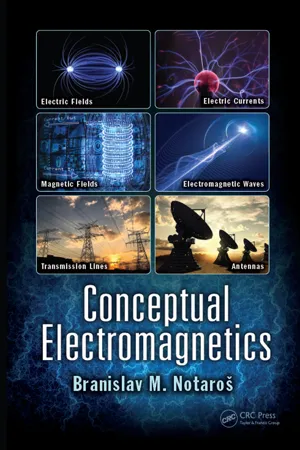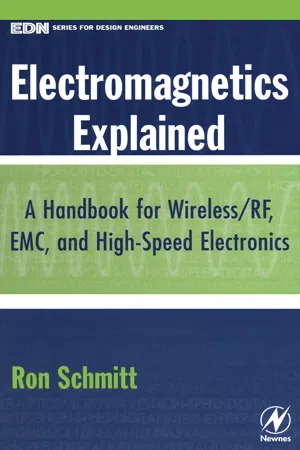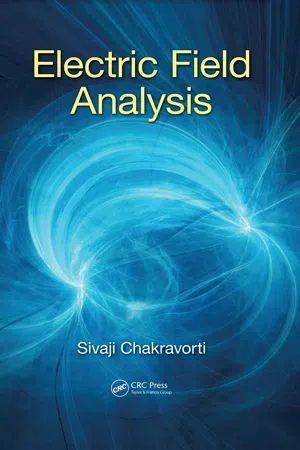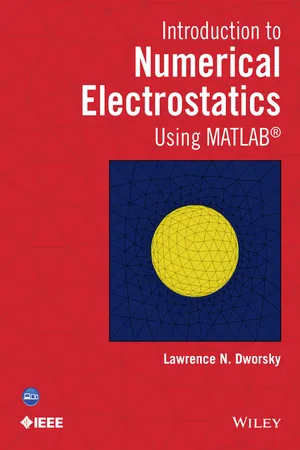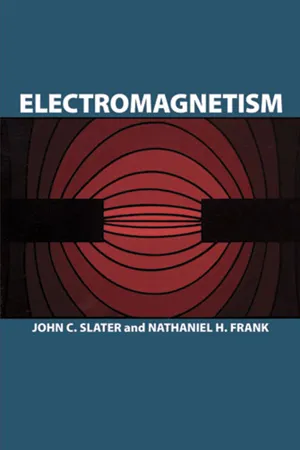Physics
Electric Field Strength
Electric field strength is a measure of the force experienced by a unit positive charge at a given point in space. It is a vector quantity, meaning it has both magnitude and direction. The electric field strength is determined by the distribution of charges in the vicinity and is a fundamental concept in understanding the behavior of electrically charged particles.
Written by Perlego with AI-assistance
Related key terms
9 Key excerpts on "Electric Field Strength"
- eBook - ePub
- Jo Verhaevert(Author)
- 2024(Publication Date)
- Routledge(Publisher)
E is measured in N/C. So potential gradient and Electric Field Strength must be one and the same thing. Now, Electric Field Strength is defined in terms of the ratio of the force exerted on a charge to the value of the charge. This is actually an extremely difficult thing to measure. However, it is a very simple matter to measure the p.d. and distance between the charged plates. Hence, for practical purposes, Electric Field Strength is from now on quoted in the units volt/metreE =V d(3.6) Notice that the symbol E (in bold) has been used for Electric Field Strength. This is in order to avoid confusion with the symbol E (in italic) used for emf.Worked Example 3.3Q Two parallel plates separated by a dielectric of thickness 3 mm acquire a charge of 35 mC when connected to a 150 V source. If the effective cross-sectional area of the field between the plates is 144 mm2 , calculate (a) the Electric Field Strength and (b) the flux density.d = 3 ×m; Q = 35 ×10− 3C; V = 150 V ; A = 144 ×10− 310− 6m 2- (a)
E =V d== 50 kV/m1503 ×10− 3- (b)
D =Q A== 243.135 ×10− 3144 ×10− 6C/m23.5 Capacitance (C)
We have seen that in order for one plate to be at a different potential to the other one, there is a need for a charge. This requirement is known as the capacity of the system. For a given system the ratio of the charge required to achieve a given p.d. is a constant for that system. This is called the capacitance (C) of the systemC =Q V(3.7) Q = V C(3.8) From Equation (3.7) it may be seen that the unit for capacitance is the farad (F). This is defined as the capacitance of a system that requires a charge of one coulomb in order to raise its potential by one volt. The farad is a very large unit, so in practice it is more usual to express capacitance values in microfarads (uF), nanofarads (nF) or picofarads (pF).Capacitors are usually very small, so there isn’t much room to print all the crucial information on the packaging. Therefore, no more than three digits are used, with the third digit indicating how many zeros should be added to the first two digits. The corresponding number then expresses the capacitance value in pF. If only two digits are used, this directly indicates the capacitance value in pF. For example, 101 represents 100 pF and 22 corresponds to 22 pF. If it is followed by a letter, this letter then indicates the tolerance (like with the resistors): J for 5%, K for 10% and M for 20%, for example. - eBook - ePub
- Branislav M. Notaroš(Author)
- 2017(Publication Date)
- CRC Press(Publisher)
Its fundamental property is that there is a force (Coulomb force) acting on any stationary charge placed in the space. To quantitatively describe this field, we introduce a vector quantity called the electric field intensity vector, E. By definition, it is equal to the electric force F e on a small probe (test) point charge Q p placed in the electric field, divided by Q p, that is, E = F e Q p (Q p → 0) (definition of the electric field intensity vector; unit: V/m). (1.3) The unit for the electric field intensity is volt per meter (V/m). From the definition in Eq. (1.3) and Coulomb’s law, Eq. (1.1), we obtain the expression for the electric field intensity vector of a point charge Q at a distance R from the charge (Figure 1.4) E = 1 4 π ε 0 Q R 2 R ^ (electric field due to a point charge), (1.4) where R ^ is the unit vector along R directed from the center of the charge (source point) toward the point at which the field is (to be) determined (field or observation point). Figure 1.4 Electric field intensity vector due to a point charge in free space. In the general case, charge can be distributed throughout a volume, on a surface, or along a line. Each of these three characteristic continuous charge distributions is described by a suitable charge density function. The volume charge density (in a volume v) is defined as [ Figure 1.5(a) ] ρ = d Q d v (volume charge density ; unit : C / m 3), (1.5) the surface charge density (on a surface S) is given by [ Figure 1.5(b) ] ρ s = d Q d S (surface charge density ; unit: C/m 2), (1.6) and the line charge density (along a line l) is [ Figure 1.5(c) ] Q ′ = d Q d l (line charge density; unit: C/m). (1.7) Note that the symbol ρ v is sometimes used instead of ρ,. σ instead of ρ s, and ρ 1 instead of Q ′ - eBook - ePub
Electromagnetics Explained
A Handbook for Wireless/ RF, EMC, and High-Speed Electronics
- Ron Schmitt(Author)
- 2002(Publication Date)
- Newnes(Publisher)
By convention, the electric field is always drawn from positive to negative. It follows that the force lines emanate from a positive charge and converge to a negative charge. Furthermore, the electric field is a normalized force, a force per charge. The normalization allows the field values to be specified independent of a second charge. In other words, the value of an electric field at any point in space specifies the force that would be felt if a unit of charge were to be placed there. (A unit charge has a value of 1 in the chosen system of units.)Electric field = Force field as “felt” by a unit chargeTo calculate the force felt by a charge with value, q, we just multiply the electric field by the charge,The magnitude of the electric field decreases as you move away from a charge, and increases as you get closer. To be specific, the magnitude of the electric field (and magnitude of the force) is proportional to the inverse of the distance squared. The electric field drops off rather quickly as the distance is increased. Mathematically this relation is expressed aswhere r is the distance from the source and q is the value of the source charge. Putting our two equations together gives us Coulomb’s law,whereq1andq2are the charge values and r is the distance that separates them. Electric fields are only one example of fields.OTHER TYPES OF FIELDS
Gravity is another field. The gravitational force is proportional to the product of the masses of the two objects involved and is always attractive. (There is no such thing as negative mass.) The gravitational field is much weaker than the electric field, so the gravitational force is only felt when the mass of one or both of the objects is very large. Therefore, our attraction to the earth is big, while our attraction to other objects like furniture is exceedingly small.Another example of a field is the stress field that occurs when elastic objects are stretched or compressed. For an example, refer to Figure 2.2 . Two balls are connected by a spring. When the spring is stretched, it will exert an attractive force on the balls and try to pull them together. When the spring is compressed, it will exert a repulsive force on the balls and try to push them apart. Now imagine that you stretch the spring and then quickly release the two balls. An oscillating motion occurs. The balls move close together, then far apart and continue back and forth. The motion does not continue forever though, because of friction. Through each cycle of oscillation, the balls lose some energy until they eventually stop moving completely. The causes of fiction are the air surrounding the balls and the internal friction of the spring. The energy lost to friction becomes heat in the air and spring. Before Einstein and his theory of relativity, most scientists thought that the electric field operated in a similar manner. During the 1800s, scientists postulated that there was a substance, called aether, which filled all of space. This aether served the purpose of the spring in the previous example. Electric fields were thought to be stresses in the aether. This theory seemed reasonable because it predicted the propagation of electromagnetic waves. The waves were just stress waves in the aether, similar to mechanical waves in springs. But Einstein showed that there was no aether. Empty space is just that—empty.* - eBook - ePub
Human Exposure to Electromagnetic Fields
From Extremely Low Frequency (ELF) to Radiofrequency
- Patrick Staebler(Author)
- 2017(Publication Date)
- Wiley-ISTE(Publisher)
Chapter 3 .Table 1.1. Summary of electric fieldsKey points of electric fieldsThe level of electric fields is expressed in volts per meter (V·m–1 or V/m).An electric field appears in the presence of electric charges. These charges can be the result of a difference in potential (voltage). That means a field exists as soon as an electric device is connected to the power supply, even if it is not working. The field strength decreases with the distance from the source. An electric field can make electric charges move. The electric field alters the distribution of charges on the surface of a conducting object. Reciprocally, an object that is slightly or highly conductive alters the field. A distinction should be made between the ambient electric field and the electric field induced within an object during exposure. Most construction materials protect against electric fields to some extent. 1.1.3. Magnetic fields
A magnetic field is created when electric charges move to form a current. There can be no magnetic field without an electric current.The force lines of the magnetic field form concentric circles along a conductor in which a current is flowing. These circles (forces) are perpendicular to the conductor, as shown in Figure 1.4 .Magnetic field line around a wireFigure 1.4.The magnetic field is characterized by its strength, represented by the symbol H and measured in amperes per meter (A·m–1 ). This quantity is proportional to the intensity of the electric current and decreases with distance. For a spatially isolated, straight electric wire, the field is expressed by (Biot–Savart law):[1.4 ]where I represents the electrical intensity in amperes (A) and d is the distance to the wire in meters. A current of 100 A intensity creates a magnetic field of 15.9 A·m–1 at a distance of 1 m.A continuous current creates a static magnetic field, like a permanent magnet. An alternating current creates an alternating magnetic field. - David V. Guerra(Author)
- 2023(Publication Date)
- CRC Press(Publisher)
⇀ . The direction of the electric field is directly away from the charged particle if the charge of the particle is positive, and directly toward the charged particle if the charge of the particle is negative.5.4.2 Examples of Computing Electric Field Strength
Example 5.1An object having a spherically symmetric charge distribution amounting to a total charge of −2 μC is located at the origin of a Cartesian coordinate system. Find the x-component of the electric field at an empty point in space at a distance of 2.00 cm away from the center of the object, in the +x direction (Figure 5.9 ).- Step 1: Draw the diagram: The electric field is in the –x direction because the electric field at an empty point in space, p, is in the direction of the force that would be experienced by a positively charged “test” particle if the positively charged particle were at that empty point in space, and a positively charged particle would be attracted by the given negatively charged particle at the origin, meaning the positively charged particle would experience a force in the –x direction. So, that is the direction in which E points.
- Step 2: Compute the magnitude of the electric field at this point of space
E = ( kq s) /r 2E = ( 9.00 ×10 9Nm 2/C 2) ( 2 ×10C ) /− 6(2.02 m)E = 4.5 ×10 7N / C
- Step 3: Compute the components of the electric field at the point of space.
E x= E cos ( 180 ° ) = − 4.5 ×10 7N / C
Example 5.2Suppose that a particle having charge +5 μC is in place at the location (2 cm, 0) at which the electric field was computed in Example 1. Find the magnitude and direction of the electric force that the particle having charge +5 μC would be experiencing.- eBook - ePub
- Sivaji Chakravorti(Author)
- 2017(Publication Date)
- CRC Press(Publisher)
1Fundamentals of Electric Field
ABSTRACT Leaving aside nuclear interactions, there are two non-contact forces that act at a distance, namely, gravitational and electric forces. Gravitational force is dominant at large distances whereas electric forces are dominant at shorter distances. The root cause of electric forces is electric charge. The effect of electric charge is spread over the entire space around it, but it falls rapidly with distance. The presence of an electric field is detected by observing the force on a charged body located within the field region. Electric field intensity is obtained by dividing the electric force by the magnitude of the test charge. To have an electric field parameter, which is independent of the charge of the test body, electric potential is introduced in the analysis, such that electric field intensity, which is a vector quantity, is the spatial derivative of electric potential, which is a scalar quantity. For a given material, electric field intensity depends on the electric flux density, which in turn depends on the amount of source charges present in the field region. For the purpose of electric field analysis, several types of charge configurations are considered, such as point, line, ring and disc charges.1.1 Introduction
When I was a student of third semester in engineering degree course, I had an unassuming yet a man of profound knowledge as our teacher who taught us electric field theory. In the very first class, he asked us a simple question: ‘Could you name just one thing which is the cause of electric field?’ Then he went on to explain the answer to that question, which is ‘Electric Charge’. It struck a chord somewhere within me, and I explored further on the effects of electric charge. From that day onwards, I was hooked to electric charge.To quote the legendary physicist, Richard Feynman, ‘Observation, reason, and experiment make up what we call the scientific method’. This is precisely true for electric field theory. Students often ask me how I discussed so many things about electric field when nobody has seen electric field. Yes, it is true that electric field cannot be directly seen. But observations on physical occurrences and related reasoning give theoretical understanding and when such understanding is validated by experimentation, then it establishes the existence of electric field. - Nima Gharib, Javad Farrokhi Derakhshandeh, Peter Radziszewski(Authors)
- 2022(Publication Date)
- Elsevier(Publisher)
Coulomb's law and electric field 3.1. Coulomb's law The basic electromagnetic concepts are studied one by one in sequence. A dimensional description will suffice in the vast majority of cases; the latter will be deduced from their relationship via the theory's basic equations, which will be tested experimentally. The next section will take place immediately after the current enumeration of essential concepts. To understand how much force does a single point charge q exert on a test charge Q while it is at rest r distance away, Coulomb's law can evaluate the answer as follows: (3.1) The constant ε 0 = (8.85 × 10 − 12 C 2 /N m 2) is referred to as open space permittivity (ludicrously). In SI units, newton (N) denotes force, meter (m) denotes distance, and coulomb denotes charge (C). In other words, the force is proportional to the charge product and inversely proportional to the square of the separation distance. Here, item Δ r is the separation vector with magnitude of r. The force is directed down the line q-Q ; it is repulsive if q and Q have the same sign, and attractive if they have the opposite sign. Coulomb's law and the principle of superposition provide the physical basis for electrostatics; all else is mathematical development of these basic laws, with the exception of a few specific features and elaboration these rules. 3.2. The electric field If there are many point charges, such as q 1, q 2, …, q n at distances r 1, r 2, …, r n from Q, the total force on Q is then equal to (3.2) or (3.3) Here, (3.4) Factor E (r) is referred to as the source of electric field charge, which is a function of position (r), since the separation vectors r i are location-dependent. However, it makes no mention of the test charge Q. The electric field is a vector quantity that varies across points and is governed by the arrangement of source charges as shown in Fig. 3.1 ; physically, E (r) is the force per unit charge that would be exerted on a test charge if placed at P. 4- Lawrence N. Dworsky(Author)
- 2014(Publication Date)
- Wiley-IEEE Press(Publisher)
The materials to follow are intended to be a quick review of the relationships that will be used throughout this book. The intent here is to provide a consistent set of notation using all the relationships that will be needed going forward. Many of these relationships are stated without derivation or proof. A more complete electrostatics theory text is recommended for newcomers to the subject. There are very many excellent texts available. The references list at the end of this chapter is certainly not exhaustive, but the texts cited are considered standards in the field.1.1 Charge, Force, and the Electric Field
Electric charges exert forces on one another. This is the basis of electrostatics. The characteristics of these forces are summarized in Coulomb’s law:- Electric charge carries a polarity, or sign. The choice of sign was originally arbitrary, but now is established by tradition—the electron, the most common charged subatomic particle, carries a negative charge.
- For point charges q1 and q2 , measured in coulombs, the (coulomb) force, measured in newtons, in a uniform medium, is given by
(1.1 )
- In equation (1.1 ) and elsewhere ε is the permittivity of the material in farads per meter (F/m). In free space, ε = ε0 = 8.854 F/m. For other linear, isotropic, homogeneous materials, ε = kε0 , where k is the relative permittivity, the relative dielectric constant, or sometimes simply the dielectric constant, of the material. Farads per se are defined as coulombs per volt (C/V). In this book we shall consider only linear, isotropic, homogeneous dielectric materials, and going forward this will be assumed.
- In equation (1.1 ) r is the distance between q 1 and q 2 .
- Also, is a unit vector along the line connecting q 1 and q 2 . If q 1 and q 2 have the same sign, then is pushing q 1 and q 2 apart. If q 1 and q 2 have opposite signs, is pulling them together.
Equation (1.1 ) is expressed in the rationalized meter-kilogram-second (mks) system of units. The derivation of this set of units is an interesting discussion in itself.2When a test charge is in the area of a collection of charges and the magnitude of these latter charges is sufficient, relative to the test charge, to render negligible any perturbation of the situation due to the test charge, then the force on the test charge divided by its charge is defined to be the electric field at that point (typically called the field point). The electric field at (the field point) p due to a charge q- eBook - ePub
- John C. Slater, Nathaniel H. Frank(Authors)
- 2012(Publication Date)
- Dover Publications(Publisher)
We find that different charges at the same point of space are acted on by different amounts of force, and we arbitrarily define the strength of the charge as being proportional to the magnitude of force acting on it in a given field. We shall see later how to define the unit of charge, the coulomb. We can define two vectors at every point of space, E the electric intensity, B the magnetic induction, such that the force F on a charge of q coulombs moving with velocity v is given by the vector equation (1.1) Here v × B is the vector product of v and B, a vector at right angles to both, whose magnitude is the product of the magnitudes of v and B times the sine of the angle between. The reader unfamiliar with this and other aspects of vector notation will find vector methods discussed in Appendix I. To measure E and B we need only measure the force on a moving charge at the point in question. The second term is the ordinary motor rule, that the force on a current element is proportional to the current, and the component of magnetic field at right angles to it, and is at right angles to each. In the mks (meter-kilogram-second) system of units, which we shall use, the force will be given by (1.1) in newtons (1 newton = 10 5 dynes), if the charge q is in coulombs, if E is in volts per meter, v in meters per second, and B in webers per square meter (1 weber/sq m = 10 4 gausses). The mks system of units is discussed in Appendix II, in which a discussion is also given of various other commonly used sets of units, and of the form that familiar equations take in these other units
Index pages curate the most relevant extracts from our library of academic textbooks. They’ve been created using an in-house natural language model (NLM), each adding context and meaning to key research topics.

